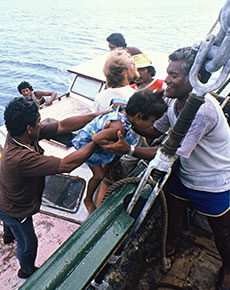Rainbow Warrior redux: How French nuclear terrorism changed the Pacific

Opinion piece by Professor David Robie of AUT’s School of Communication Studies, who travelled on board the Rainbow Warrior for 10 weeks before the bombing and wrote the book Eyes of Fire. A fresh edition was published this week.
New Zealand wasn’t the only target of French state-backed terrorism three decades ago. Nor was the Rainbow Warrior when this peaceful environmental campaign ship was bombed by secret agents under our noses.
The attack on the Greenpeace campaign flagship on 10 July 1985 was part of a Pacific-wide strategy to crush pro-independence and nuclear-free movements in both New Caledonia and French Polynesia during the 1980s.
This was not widely understood in New Zealand at the time or reported on by local media.
Opération Satanique, as the “satanic” Rainbow Warrior sabotage plan was aptly named, got the green light because of political rivalry between then socialist President François Mitterrand and right-wing Prime Minister Jacques Chirac that pushed them into cynical point-scoring against each other.
Although misleading and laughable as early Australian or New Zealand press reports were about who was thought to be responsible for the bombing in Auckland Harbour - focusing on mercenaries, or the French Foreign Legion based in New Caledonia and so on - there was certainly a connection with the neocolonial mind-set of the time.
New Caledonia then had the largest military garrison in the Pacific, about 6000 French Pacific Regiment and other troops, larger than the New Zealand armed forces, with about one soldier or paramilitary officer for every 24 citizens in the territory – the nearest Pacific neighbour to Auckland, less than a three hour flight away.
A small Pacific fleet included the nuclear submarine Rubis, reputed to have picked up one unit of the French secret service agents involved in Operation Satanic off the yacht Ouvea, scuttling her in the Coral Sea, and then spirited them to safety in Tahiti.
Rights violations
A long line of human rights violations and oppressive acts were carried out against Kanak activists seeking independence starting with a political stand-off in 1984, a year before the Rainbow Warrior bombing.
Parties favouring independence came together that year under an umbrella known as the Front de Libération Nationale Kanak et Socialiste (FLNKS) and began agitating for independence from France with a series of blockades and political demonstrations over the next four years.
The struggle echoed the current Melanesian activism in West Papua today with advocates seeking political justice and independence from Indonesian colonial rule.
The Greenpeace tragedy was one of several happening in the Pacific at the time, and this was really overshadowed by the Rongelap evacuation when the Rainbow Warrior crew ferried some 320 islanders, plagued by ill-health from the US atmospheric mega-nuclear tests in the 1950s, from their home in the Marshall Islands to a new islet, Mejato, on Kwajalein Atoll.
Bloody incidents
Over the next few years, after the start of the Kanak uprising, New Caledonia suffered a series of bloody incidents because of hard-line French neo-colonial policies:
- The Hiènghene massacre on 5 December 1984 when 10 unarmed Kanak political advocates were ambushed by heavily armed mixed-race French settlers on their way home to their village after a political meeting. (Charismatic Kanak independence leader Jean-Marie Tjibaou lost two brothers in that ambush when almost all the menfolk of the village of Tiendanite were gunned down in one deadly night.)
- The assassination of Kanak independence leader Eloï Machoro and his deputy, Marcel Nonaro, by French special forces snipers at dawn on 12 January 1985 during a siege of farmhouse at Dogny, near la Foa.
- The infamous cave siege of the island of Ouvea when French forces used a “news media” helicopter as a ruse to attack 19 young militant Kanaks holding gendarmes hostage, killing most of them and allegedly torturing wounded captives to death. The 11th Shock Unit carried out this attack – the same unit (known then as the Service Action squad) to carry out Operation Satanic against the Rainbow Warrior.
- The human rights violations involved in this attack were exposed in the 2012 docu-drama movie Rebellion by director Mathieu Kassovitz, based on a book by a hostage negotiator who believed he could have achieved a peaceful resolution.
- France had its problems in Vanuatu too. Founding Prime Minister Father Walter Lini’s government expelled ambassador Henri Crepin-Leblond shortly before the election on 30 November 1987, accusing Paris of funding the opposition Union of Moderate Parties – a claim denied by the French.
- There were also riots in French Polynesia when young Tahitians set the capital ablaze with demands of an end to nuclear testing and to colonial rule. But these came a decade later in September 1995 after mounting tensions.
- Two years later, in December 1997, a French Polynesian journalist known for his liberal views Les Nouvelles de Tahiti editor Jean-Pascal Couraud, known as “JPK”, disappeared and he was believed assassinated by local presidential special ops militia.
Social scars
The social scars from these events affected France’s standing in the Pacific for many years. While relations have dramatically improved since then, it still rankles with both many New Zealanders and Greenpeace campaigners that Paris has never given a full state apology.
Then it seemed highly unlikely that in less than two decades nuclear testing would be finally abandoned in the South Pacific (1996), and Tahiti’s leading nuclear-free and pro-independence politician, Oscar Manutahi Temaru, would emerge as French Polynesia’s new president four times (from 2004) and usher in a refreshing “new order” with a commitment to pan-Pacific relations.
Although Tahitian independence is nominally off the agenda for the moment, far-reaching changes in the Pacific region are inevitable.
Watch a Pacific Media Centre video interview with David Robie here:
Rainbow Warrior release: Book launch: 30 years On